Italy's unique wildlife offers an incredible journey from the majestic Alps to the vibrant Mediterranean coast. You'll find over 57,000 animal species thriving in diverse habitats, including rare mammals like the Italian wolf and critically endangered Marsican brown bear. The country's rich ecosystems also host endemic amphibians, various reptiles, and stunning marine life. Italy's varied climates elevate its biodiversity to remarkable heights. Explore national parks and engage with local experts to enhance your experience. As you discover more about Italy's wildlife, you'll uncover the critical conservation efforts aimed at protecting these extraordinary species and their habitats.
Key Takeaways
- Italy is home to over 57,000 animal species, including 4,777 endemic species, showcasing rich biodiversity from the Alps to the Mediterranean.
- Unique mammals such as the Italian wolf and critically endangered Marsican brown bear highlight Italy's distinctive wildlife.
- Diverse ecosystems support various reptiles, amphibians, and 516 bird species, including the culturally significant Italian sparrow.
- Italy's coastal waters are rich in marine life, featuring over 1,000 invertebrate species and iconic marine mammals like bottlenose dolphins.
- Conservation efforts, including 20 national parks, aim to protect endemic species and habitats threatened by human activities and environmental changes.
Overview of Italy's Biodiversity
Italy is a treasure trove of biodiversity, boasting over 57,000 recorded animal species, the highest in Europe. This incredible variety stems from its diverse ecosystems, which range from the towering Alps to the sun-drenched Mediterranean coast. Each habitat supports unique wildlife, making Italy a remarkable haven for nature lovers.
The country's commitment to sustainable practices can also be seen in its efforts to harness renewable energy, including geothermal energy, which contributes to preserving these natural environments.
You'll discover about 4,777 endemic species, showcasing the country's rich biological heritage. The 119 mammal species include iconic animals like the Italian wolf and the Marsican brown bear, while the tiny Etruscan shrew holds the title of the smallest mammal in the world.
Italy's bird population is equally impressive, with around 550 species, including essential migratory routes for trans-Saharan birds and the beloved Italian sparrow, the national bird.
Don't overlook the marine biodiversity, where aquatic life thrives with 623 fish species, including nine endemic freshwater fish. The marine ecosystems are home to over a thousand species of invertebrates, reflecting the intricate web of life in Italy's waters.
With such a diverse array of wildlife and ecosystems, Italy offers a stunning glimpse into the wonders of nature.
Unique Species and Endemism
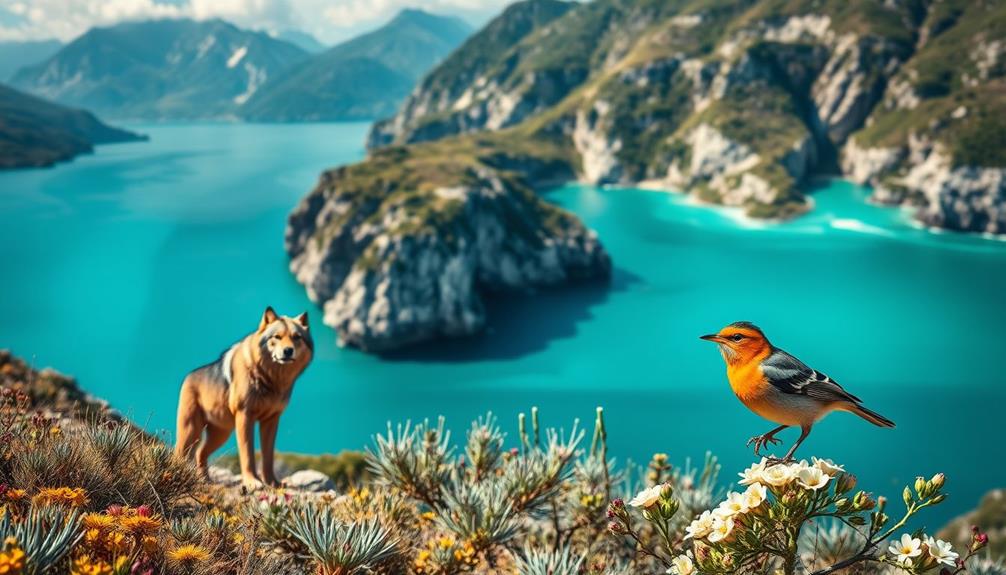
Exploring Italy's unique species reveals an extraordinary world of endemism, where many creatures exist nowhere else on the planet. You'll find approximately 4,777 endemic species, including notable mammals like the Apennine wolf and the majestic Marsican brown bear.
In Italy's lush landscapes, amphibians thrive, featuring the spectacular spectacled salamander and the Italian newt, both reflecting the country's rich biodiversity. The cultural significance of these species can be likened to the ways indigenous symbols convey deep meanings in Aboriginal art concepts.
When you investigate the insect world, Italy boasts 288 endemic lepidopteran species, such as the striking European owl moth, adding to its impressive insect biodiversity. The Alpine marmot, another distinct mammal, roams the mountainous areas, showcasing the unique adaptations of wildlife here.
Italy's freshwater ecosystems are equally fascinating, supporting nine endemic fish species like the Bergatino loach and Italian barbel. These species highlight the essential need for conservation efforts, ensuring that these unique habitats remain protected.
Geographic and Climate Influences
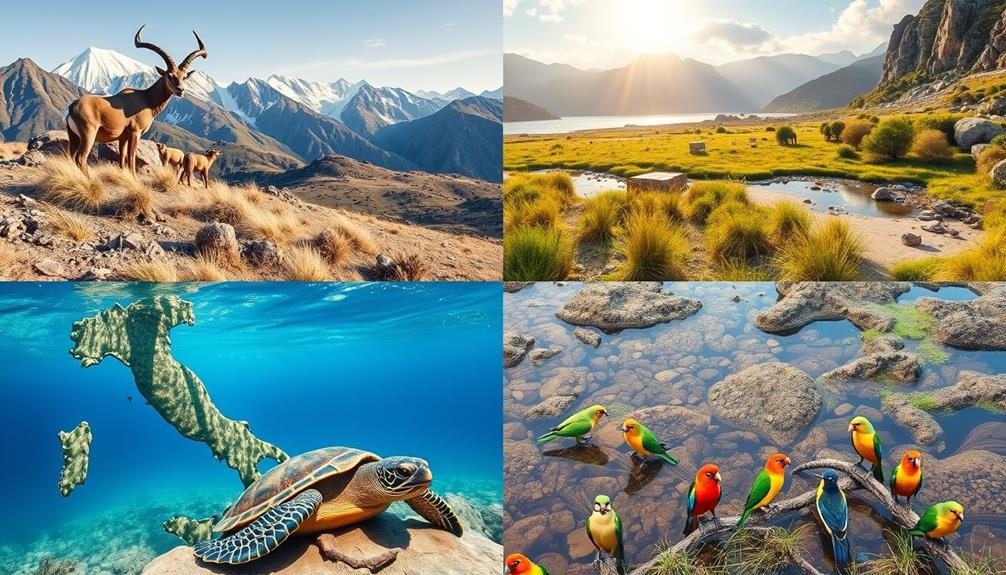
The diverse geography of Italy, with its extensive 1,000 km peninsula and towering Alps, creates a myriad of habitats that nurture a wide range of unique wildlife. This geographic diversity plays an essential role in shaping the country's climate, which varies from humid subtropical in the north to Mediterranean in the coastal and southern regions.
These climatic differences influence the types of flora and fauna that thrive in each area, much like how understanding plant properties enhances essential knowledge for herbalism.
Italy's rich biodiversity is supported by distinct ecoregions, such as the Illyrian deciduous forests and Apennine montane forests, each offering unique habitats for various species.
The Mediterranean Basin, recognized as a biodiversity hotspot, is home to over 57,000 recorded animal species, many of which are endemic. The unique cave systems across the country create specialized microhabitats that further enhance Italy's ecological diversity.
Together, these factors contribute greatly to Italy's faunal biodiversity, making it a remarkable destination for wildlife enthusiasts.
As you explore this beautiful country, you'll appreciate how its geographic and climate influences shape the unique wildlife that calls it home.
Terrestrial Ecoregions of Italy
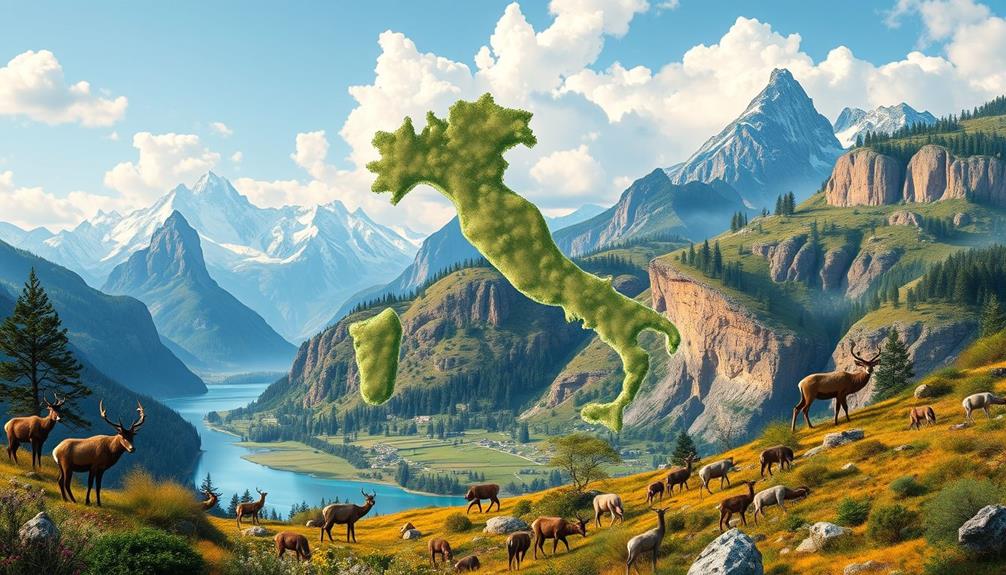
Diversity defines Italy's terrestrial ecoregions, each offering distinct habitats that support a wealth of wildlife. These ecoregions include the lush Apennine montane forests, where you might encounter the elusive Alpine ibex and the Apennine chamois, both thriving in this rich biodiversity. In the Dinaric Mountains mixed forests, you'll find a blend of coniferous and deciduous trees, providing sanctuary for the majestic Eurasian lynx and various birds of prey.
The Po Basin mixed forests, despite being heavily agricultural, still support diverse wildlife populations, including the charming Italian sparrow and numerous amphibians. Additionally, Italy's significant cave systems contribute to its ecological complexity, harboring unique species adapted to subterranean life.
Here's a glance at some key terrestrial ecoregions:
| Ecoregion | Key Species | Notable Features |
|---|---|---|
| Apennine Montane Forests | Alpine ibex, Apennine chamois | Rich biodiversity |
| Dinaric Mountains Mixed Forests | Eurasian lynx | Mix of coniferous and deciduous trees |
| Po Basin Mixed Forests | Italian sparrow | Agricultural and industrial landscape |
| Illyrian Deciduous Forests | Diverse wildlife populations | Mixed broadleaf and coniferous trees |
Exploring these ecoregions reveals Italy's incredible natural heritage.
Mammals of Italy

Italy's diverse habitats host a fascinating range of mammal species, including unique endemics like the Italian wolf and Marsican brown bear.
These mammals play significant roles in their ecosystems, similar to how quorum sensing in bacteria is fundamental for bacterial communication and coordination.
You're likely to encounter both widespread and rare mammals, each facing various conservation challenges.
Understanding their habitats and the threats they face is essential for preserving Italy's rich wildlife.
Endemic Mammal Species
When exploring Italy's wildlife, you'll encounter several fascinating endemic mammal species that showcase the country's unique ecological heritage. Among these, the Italian wolf stands out as a national symbol, with a population of about 600-700 individuals primarily roaming central and southern Italy.
The critically endangered Marsican brown bear, found in the Apennine Mountains, is one of the rarest bear species globally, with only 50-60 bears remaining in the wild. Additionally, just like the tough dog names often chosen for strong personalities, the Italian wolf embodies strength and resilience in its natural habitat.
You'll also discover the Etruscan shrew, the smallest mammal in the world, weighing just about 1.8 grams and measuring around 3.5 to 5.2 centimeters in length.
The Sardinian long-eared bat and the Sardinian porcupine further enrich Italy's diversity of unique wildlife, each adapted to specific habitats across the region.
As you explore the varied landscapes—from the rugged mountains to the tranquil coastlines—you'll appreciate how these endemic mammal species reflect Italy's rich biodiversity.
Whether you're hiking in the Apennine Mountains or wandering through Sardinia, keep an eye out for these remarkable creatures that contribute to Italy's distinctive ecological tapestry.
Habitat Diversity
The varied landscapes of Italy provide a rich tapestry of habitats that support a wide range of mammal species. From the Alpine regions to the Apennine mountains, each area offers unique conditions that foster diverse wildlife, making it crucial to understand the ecological balance these mammals maintain.
You can find a remarkable array of mammals, including:
- Alpine ibex – These agile climbers thrive in mountainous terrains.
- Marsican brown bear – The largest mammal in Italy, it's critically endangered with only 50-60 individuals remaining.
- Wild boar – Found in forests and agricultural areas, they play significant ecological roles.
- Red deer – These magnificent creatures roam various landscapes, contributing to habitat diversity.
Italy's unique mammalian diversity includes notable species like the Apennine wolf, which symbolizes national pride. The Etruscan shrew, the smallest mammal in the world, further showcases the country's rich wildlife.
The ecological roles of these mammals are crucial, as they help maintain the balance within their habitats, emphasizing the importance of hydration strategies for their survival.
Whether you're exploring the rugged mountains or lush forests, you'll discover how each mammal contributes to Italy's vibrant ecosystems and highlights the importance of preserving these diverse habitats.
Conservation Challenges
Addressing conservation challenges for mammals in Italy requires urgent action as many species face dire threats. The Marsican brown bear, with a critically low population of only 50-60 individuals, is one of the country's most endangered species.
Similarly, the Italian wolf, a vulnerable symbol of Italy, contends with habitat loss and human-wildlife conflict. Overall, approximately 28% of assessed mammal species in Italy are under threat due to habitat destruction, overexploitation, and pollution.
Implementing effective weight loss strategies can help mitigate some of the pressures on these animals by promoting sustainable practices. Conservation efforts are crucial to guarantee the survival of these unique mammals. Programs targeting the protection of the Iberian lynx and Apennine chamois are essential to preserve Italy's rich biodiversity.
However, ongoing habitat loss and environmental changes present significant obstacles. Even the Etruscan shrew, the world's smallest mammal, faces vulnerability as its habitat shrinks.
You can support these efforts by advocating for policies that protect wildlife habitats and engaging in local conservation initiatives. Every action counts in safeguarding Italy's diverse mammal population and guaranteeing future generations can appreciate the incredible wildlife that thrives across the nation.
Birds of Italy

Italy boasts an extraordinary variety of birds, with about 516 species calling the country home. Among these, around 267 species nest in Italy, showcasing its rich avian diversity.
You'll find remarkable birds of prey like the Peregrine Falcon, Golden Eagle, and Eurasian eagle-owl thriving in various habitats. The significance of these birds extends beyond their beauty, as they contribute to ecological balance and play an essential role in their ecosystems, enhancing the benefits of nature-based play.
Italy's unique ecosystems also support a range of common songbirds, enhancing the soundscape of the countryside. The Italian sparrow, recognized as the national bird, holds cultural significance and can be spotted in urban areas.
When exploring Italy's avian life, consider these key highlights:
- Diverse Habitats: From the Alps to the Mediterranean, birds adapt to different environments.
- Seasonal Migratory Routes: Italy serves as a vital stopover for trans-Saharan birds during migration.
- Nesting Sites: Various birds find safe nesting spots across the country, ensuring their survival.
- Cultural Symbols: Birds like the Italian sparrow reflect Italy's rich heritage.
Whether you're a birdwatcher or simply enjoy nature, Italy's birds offer a fascinating experience that you won't want to miss.
Reptiles and Amphibians
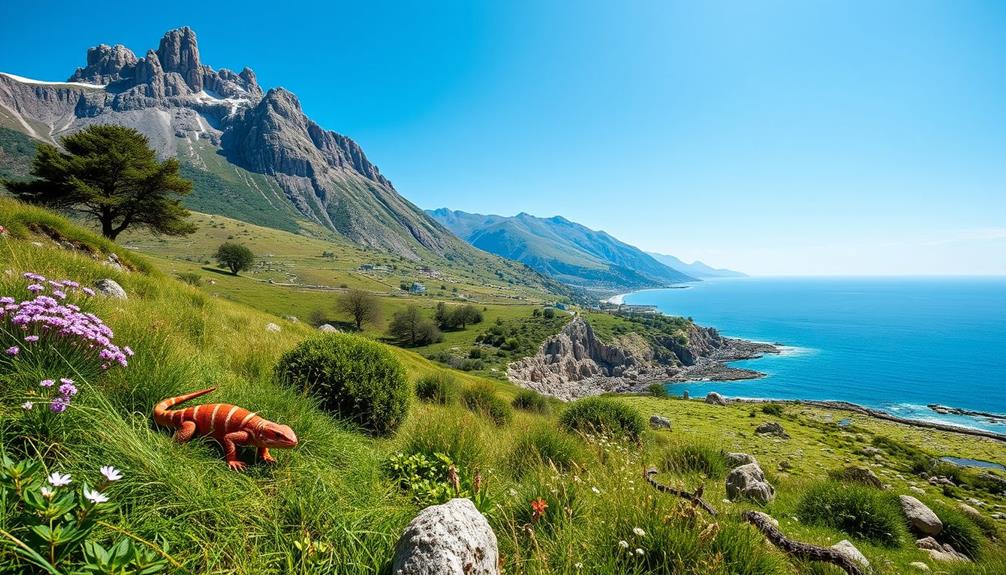
What makes Italy's reptiles and amphibians so fascinating? With around 69 reptile species and 39 amphibian species, Italy boasts a rich diversity of herpetofauna. You can find remarkable species like the Italian tree frog and the Italian newt, as well as various tortoises and lizards. The unique endemic amphibians, such as the spectacled salamander, highlight Italy's distinct biodiversity.
The diverse habitats across Italy — from lush forests to serene wetlands — create vital environments for these creatures. However, habitat destruction and pollution threaten their survival, making conservation efforts essential.
Here's a quick overview of some key reptile and amphibian species:
| Type | Notable Species | Conservation Status |
|---|---|---|
| Reptiles | Dice snake, Green whip snake | Vulnerable |
| Amphibians | Italian tree frog, Fire salamander | Endangered |
| Endemic Species | Italian newt, Spectacled salamander | Critical |
Marine Life in Italian Waters

Exploring the unique wildlife of Italy naturally leads to its vibrant marine life, which thrives in the country's coastal waters. The Italian coastal waters are renowned for their ecological richness, harboring a diverse array of marine species. Not only do these waters host an impressive variety of creatures, but they also benefit from well-preserved underwater habitats that enhance their biodiversity, similar to the way well-draining soil supports healthy plant growth.
Here are some highlights you won't want to miss:
- Invertebrates: Over 1,000 species, including the common octopus and Mediterranean jellyfish, showcase the area's biodiversity.
- Posidonia Oceanica: These underwater meadows are essential habitats that support marine life and enhance ecosystem health.
- Marine Mammals: You might encounter iconic species like the bottlenose dolphin and the fin whale, both of which benefit from ongoing conservation efforts.
- Unique Species: Look for the purple sea urchin and the Mediterranean slipper lobster, both of which add to the area's distinctive marine character.
The Mediterranean Sea off Italy is a treasure trove of marine wonders. From the vibrant underwater landscapes to the fascinating creatures that inhabit them, Italy's marine environments offer endless opportunities for exploration and appreciation.
Your adventure in these waters will surely reveal the remarkable diversity of life beneath the surface.
Conservation Challenges and Efforts
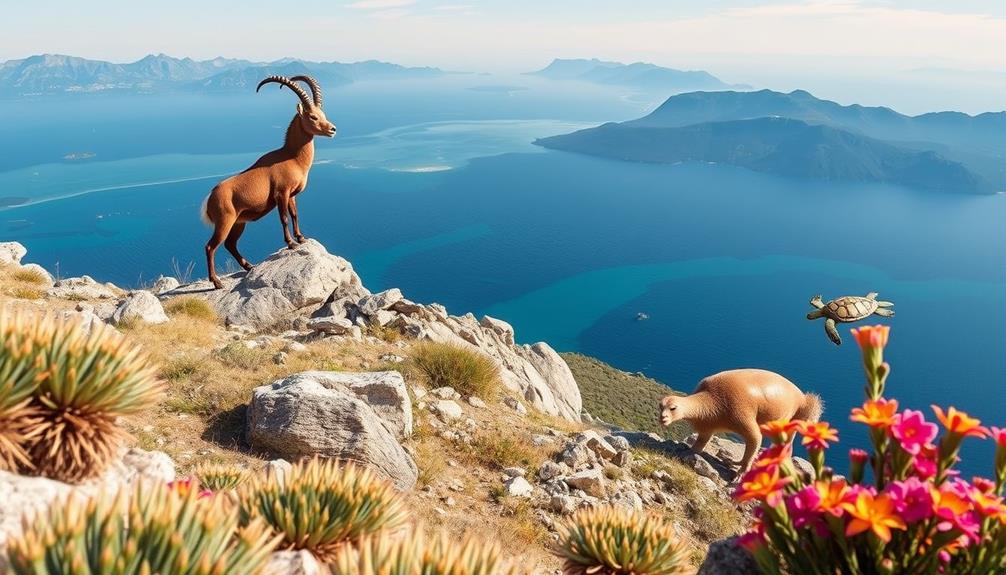
Conservation challenges in Italy are pressing, with about 28% of assessed species facing threats to their survival. This includes 138 terrestrial and 23 marine species, highlighting the urgent need for conservation efforts.
Habitat destruction, pollution, and the introduction of alien species jeopardize Italy's rich biodiversity, leading to declines in both terrestrial and marine ecosystems. Additionally, the importance of community engagement in conservation efforts resonates with initiatives like mastering survival skills that can empower individuals to contribute effectively.
To combat these issues, Italy has established a network of protected areas, including 20 national parks and 130 regional parks, as well as 150 federally protected wildlife territories and 16 marine reserves. These initiatives aim to safeguard unique habitats and support endemic species that are threatened.
Among these is the critically endangered Marsican brown bear, with a mere 50-60 individuals left, emphasizing the need for targeted conservation initiatives.
Moreover, volunteer projects focusing on dolphin and whale research in the Western Mediterranean form part of broader efforts to protect marine species from declining populations.
Wildlife Observation and Travel Tips
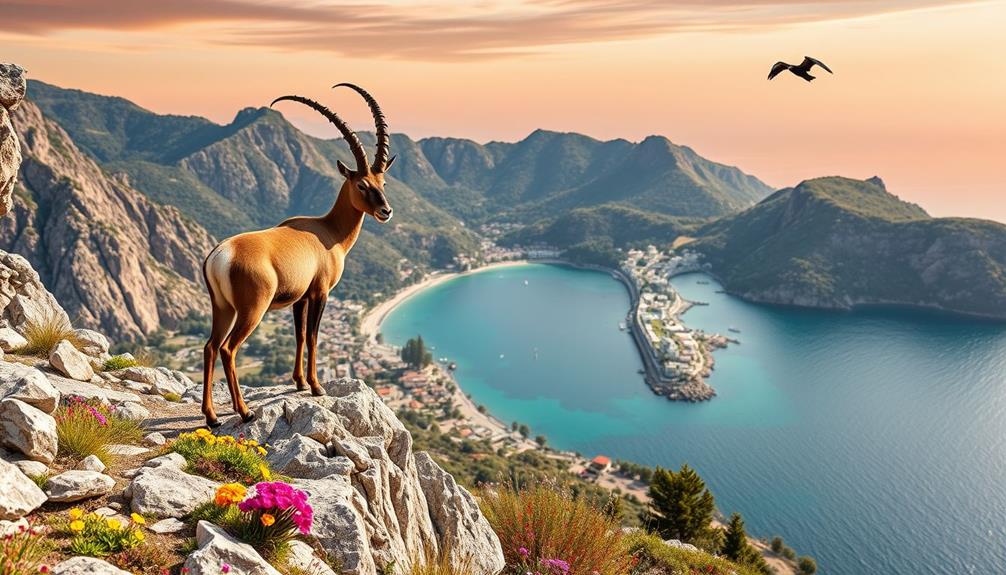
If you're keen to spot Italy's incredible wildlife, timing your outings can make all the difference. Early mornings and late afternoons are prime for wildlife observation, especially in national parks like Abruzzo and Stelvio, where animals like the Italian wolf and Marsican Bear are most active.
To enhance your wildlife watching experience, consider the following tips:
- Gear Up: Bring binoculars for distant viewing, a field guide to identify various species, and quiet, comfortable clothing to avoid disturbing wildlife.
- Explore Hiking Trails: Trails such as the Val di Rose Trail in Abruzzo offer excellent opportunities to see unique species, including the Apennine Chamois.
- Bird Watching: With over 550 bird species, keep an eye out for rare sightings while trekking through diverse habitats.
- Join Guided Tours: Engaging with local experts can deepen your understanding of animal behavior, habitats, and conservation efforts in the region.
With these tips in hand, you'll be well-prepared to explore Italy's rich biodiversity and enjoy unforgettable encounters with its unique wildlife.
Frequently Asked Questions
What Wildlife Is in the Italian Alps?
In the Italian Alps, you'll encounter diverse wildlife, including the Alpine Ibex, Eurasian Lynx, and Alpine Marmot. You might also spot Golden Eagles and unique amphibians like the Italian Tree Frog in their natural habitats.
What Is a Unique Animal in Italy?
When it comes to unique animals in Italy, you can't miss the Etruscan shrew. Weighing just 1.8 grams, it's the world's smallest mammal, showcasing nature's wonders in the most unexpected places.
What Is the Major Predator Found in the Mountains of Italy?
The major predator in Italy's mountains is the Apennine wolf. You'll find these adaptable wolves living in packs, balancing herbivore populations and thriving in diverse habitats, but they need your help to survive against threats.
Does Italy Have a National Animal?
Yes, Italy does have a national animal: the Italian wolf. This majestic creature symbolizes the country's rich heritage and plays an essential role in maintaining ecosystem balance, despite facing challenges like habitat loss and conflicts.
Conclusion
As you explore Italy's diverse landscapes, from the majestic Alps to the sun-kissed Mediterranean, you'll realize it's like an artist's palette, bursting with color and life. Did you know that nearly 58,000 species call Italy home? Just like a painter who carefully selects each hue, these species thrive in their unique habitats. By embracing conservation efforts, you can help guarantee this vibrant masterpiece endures for generations to come, inviting travelers and wildlife enthusiasts alike to marvel at its wonders.










